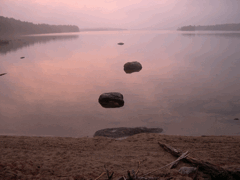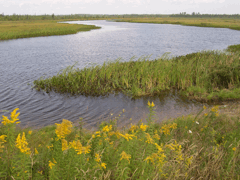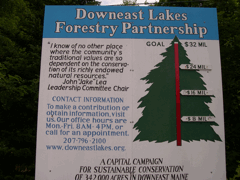Downeast Conservation
Air Date: Week of November 6, 2009

The Downeast Lakes Land Trust protects more than 60 lakes and ponds and 400 miles of lake shore. (Photo: Laurie Sanders)
An unlikely group of folks in Maine joins forces and, against tough odds, pulls together one of the largest conservation projects on the East Coast. Producer Laurie Sanders visits with members of the Downeast Lakes Land Trust to find out how they raised 32 million dollars to protect more than 340,000 acres of forest and some of the best fishing and loon habitat in the region.
Transcript
YOUNG: Anthropologist Margaret Mead famously wrote, “Never doubt that a small group of thoughtful, committed citizens can change the world. Indeed, it is the only thing that ever has.”
Well, here’s a story that illustrates Mead’s words. From the eastern most part of Maine, not far from the Canadian border, a landscape of lakes and forests. Laurie Sanders took a trip there and has our story.
SANDERS: The town of Grand Lake Stream is tiny. Only120 full-time residents. But since the 1860s, it’s had a reputation as a premiere fishing destination.
[Paddling]
The village is situated on West Grand Lake, which, with 14,000 acres, supports bass, lake trout and one of Maine’s only native populations of land-locked salmon. Steve Keith is an avid fisherman. We’re about a mile uplake from town. And from this point, we can’t see a single camp. Or boat. Or person. Just sky. And forest. And water.

Ponds and 400 miles of lake shore. (Photo: Laurie Sanders)
KEITH: If you go from this place, eastern Maine to Florida, there’s nothing like it in between. This is in many ways unchanged from when the Abenaki and the Passamoquaddy tribe, who are still here and local, plied these waters in birch bark canoes. Their ancestors would look at it, and see that it’s the same.
[Paddling]
SANDERS: And thanks to the dedication and tenacity of a small group of people, this place will look this way for generations to come.
UPHAM: We had no idea what we were getting ourselves into. You know, it seemed like we had to do something, and when we started talking to people. Everybody said go for it.
SANDERS: Jimmie Upham is a former schoolteacher, and one of six locals who, came up with an audacious plan: to protect 342,000 acres surrounding the community of Grand Lake Stream. That means forests, wetlands, lakes, the all of it.
It all began ten years ago, when Georgia Pacific, one of the nation’s largest timber companies, sold 450,000 acres in and around Grand Lake Stream to an investment interest, with Wagner Timberlands hired to manage the property. At first, no one was concerned. Big timber companies had owned land around here for decades. But within a year, that sentiment changed – says fishing guide and logger Louie Cataldo. He says Georgia Pacific had already cut the forest pretty hard, so the townspeople assumed the new owners would wait a while for the trees to grow bigger:

(Photo: Laurie Sanders)
CATALDO: But what they did, they bought the land they went around and really cut everything that was left, that was saleable. And we could see that happening, and it kinda upset because we really care about these woods. It’s important to our lifestyle.
SANDERS: The local economy here depends almost entirely on healthy forests and pristine rivers and lakes. Cataldo says with the extensive cutting they observed, these qualities were being jeopardized. Even worse, Steve Keith says there was a real threat that the timber company would start dividing up the land and selling it off as house lots.
KEITH: What we were concerned about was that all the shoreline would be subdivided and developed, and it would ruin the character of the area. If you want to experience that, you just go south of Bangor to any of the lakes in Maine or New Hampshire that are ringed with camps. The water quality goes down, the noise increases, and you don’t have an experience in nature like you can here.
SANDERS: Faced with this, a group of people came together. It included loggers and fishing guides, lodge owners and mill workers, lawyers and former business executives. It also included locals, like Cataldo, and summer people, like Keith. Their first idea was to buy a buffer around West Grand Lake, but as they talked to more people and other organizations, the scope of their project grew bigger. And bigger.
After two years, they negotiated with the timber company to buy 27,000 acres as a community forest and purchase the development rights on another 312,000 acres. But there was the price: $32 million dollars. And, a fundraising expert had told them the most they could hope to raise was two million. Again Jimmie Upham.

The Downeast Lakes Land Trust protects more than 60 lakes and ponds and 400 miles of lake shore. (Photo: Laurie Sanders)
UPHAM: The numbers were numbers that none of us had ever dealt with before. And part of it, I don’t think we had any concept of what two million was, and if we didn’t know what two million was than going from two to 32 didn’t matter a hill of beans. [laughs].
SANDERS: And Cataldo says, by then, people were fired up, and the group felt an obligation to try.
CATALDO: It was terribly frightening because we surely didn’t want to fail. It was just terrifying to think that we had to raise that kind of money, but we kept pushing on, and a few key people told us that we could do it, and of course, them’s the ones we wanted to listen to.
SANDERS: To make it happen, the group formed the Downeast Lakes Land Trust, hired Steve Keith as the executive director, and pulled in a key partner – the New England Forestry Foundation, an organization with a similar commitment to sustainable forestry, recreation and wildlife habitat protection. And, it had extensive fundraising experience. Over the next several years, the partnership hosted events, led field walks, talked to prospective donors. And donations came in, ranging in size from a single dollar to a seven million dollar gift from a private foundation. In 2005, they signed the papers on the land, but Keith says they were still short of their fundraising goal. And that’s when the New England Forestry Foundation did something creative and risky.
KEITH: We still needed six million dollars, and in order to do that the New England Forestry Foundation put up as collateral a forest they owned in eastern Massachusetts, and then we spent another two years raising that six million dollars. That may have been the most difficult part because raising money after you’ve closed on the property is extremely hard. People aren’t motivated to give you money at that point.
SANDERS: But last year, the Downeast Lakes Land Trust and New England Forestry Foundation finished raising all 32 million dollars. And with that, they protected more than 60 lakes and ponds, 400 miles of lakeshore, and some of the best loon habitat in the state of Maine. They also kept the land on the tax rolls, with most of it in working forest. And Louie Cataldo says they also assured public access for recreation to all of it. Anyone can go there, to hunt, fish, hike, or canoe.
CATALDO: When you ride up the lake and look at what we’ve protected, and knowing it’s going to be like that forever, it does make you feel real good. And I feel lucky that I got to be part of it.
SANDERS: But they’re not quite done. Earlier this year, the Land Trust began working to protect the last big parcel. A 21,000-acre block along West Grand Lake with 15 miles of lakeshore.
CATALDO: We can’t rest. If we miss a deal like this, it’ll never come back to us.
SANDERS: And the asking price? Just 24 million dollars.
For Living on Earth, I’m Laurie Sanders.
Links
Living on Earth wants to hear from you!
Living on Earth
62 Calef Highway, Suite 212
Lee, NH 03861
Telephone: 617-287-4121
E-mail: comments@loe.org
Newsletter [Click here]
Donate to Living on Earth!
Living on Earth is an independent media program and relies entirely on contributions from listeners and institutions supporting public service. Please donate now to preserve an independent environmental voice.
NewsletterLiving on Earth offers a weekly delivery of the show's rundown to your mailbox. Sign up for our newsletter today!
 Sailors For The Sea: Be the change you want to sea.
Sailors For The Sea: Be the change you want to sea.
 The Grantham Foundation for the Protection of the Environment: Committed to protecting and improving the health of the global environment.
The Grantham Foundation for the Protection of the Environment: Committed to protecting and improving the health of the global environment.
 Contribute to Living on Earth and receive, as our gift to you, an archival print of one of Mark Seth Lender's extraordinary wildlife photographs. Follow the link to see Mark's current collection of photographs.
Contribute to Living on Earth and receive, as our gift to you, an archival print of one of Mark Seth Lender's extraordinary wildlife photographs. Follow the link to see Mark's current collection of photographs.
 Buy a signed copy of Mark Seth Lender's book Smeagull the Seagull & support Living on Earth
Buy a signed copy of Mark Seth Lender's book Smeagull the Seagull & support Living on Earth

